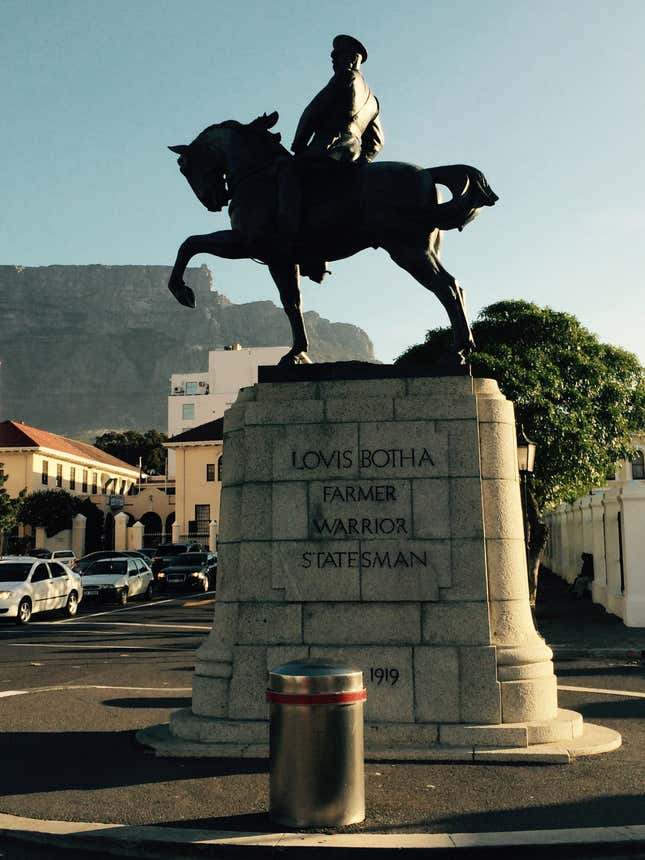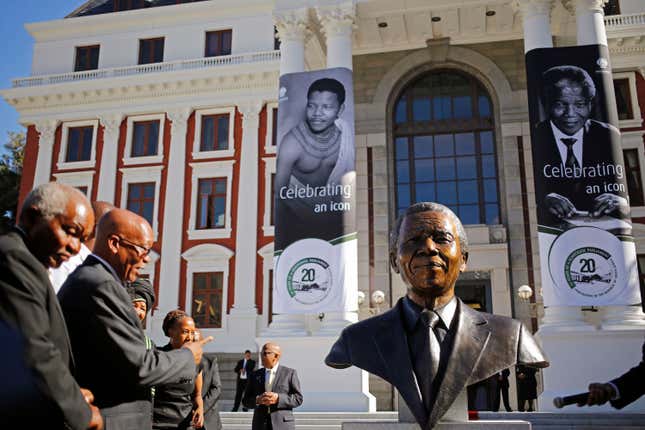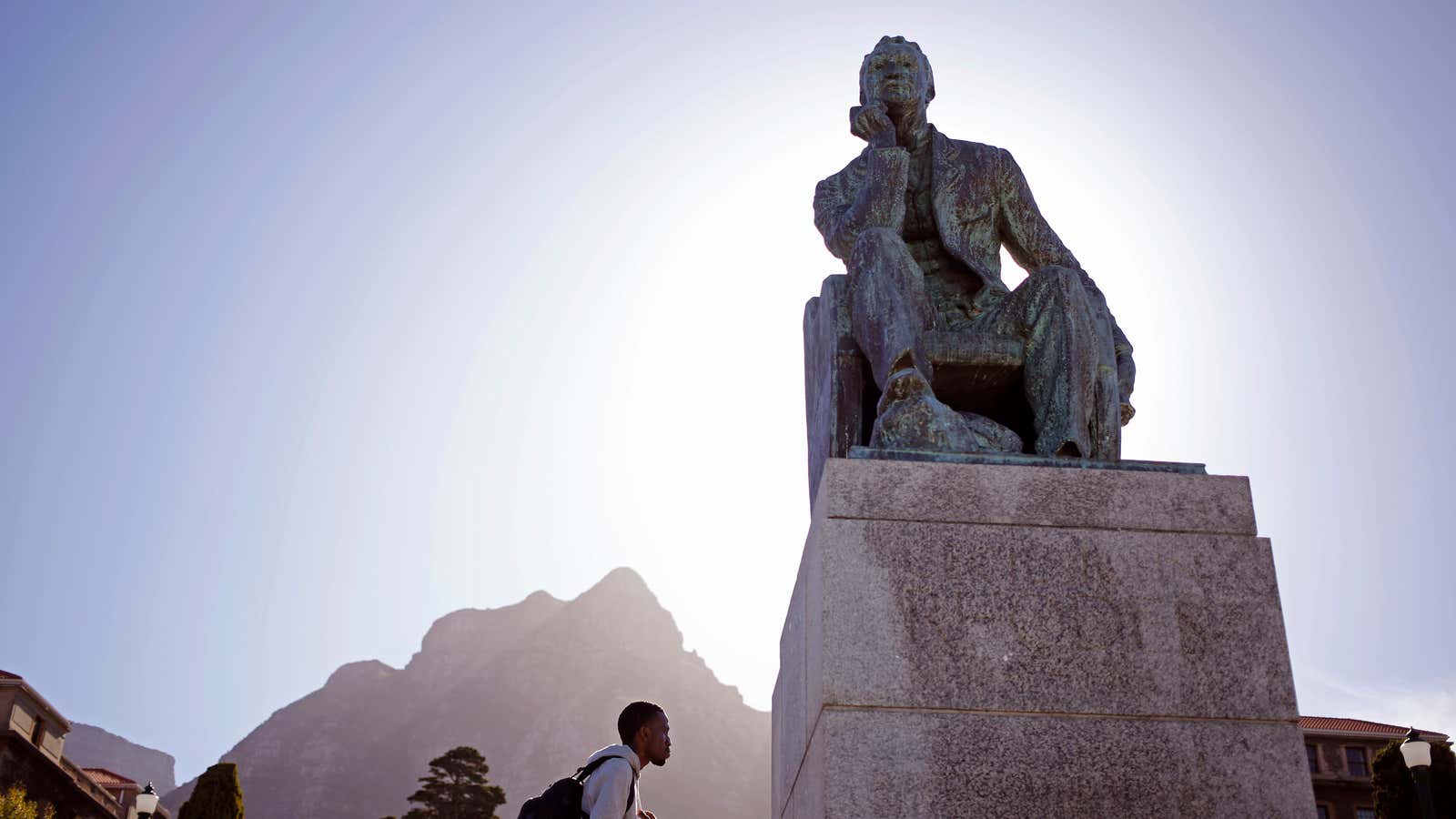What is the significance of a former statesman’s statue? This a question that has been doing the rounds in Cape Town in the last couple of weeks.
The statue of General Louis Botha, South Africa’s first colonial prime minister, towers over the entrance of Parliament. Nearby, about 200 metres away, is a far less imposing bust: of Nelson Mandela.
Why the disparity?
Botha’s legacy is contested. Some credit him as the founding father of the Union of South Africa – a project that unified the opposing Boer and British republics. But his legacy is also rooted in the exercise of brute force, one that divided South Africa along racial lines and resulted in the dominance of one group over another.
Meanwhile, the world over, Mandela is a man lauded for bringing stability to a country on the brink of a civil war, a global icon a hero to generations. Yet here’s how South Africa honors them:


The two images underscore a key debate in South Africa: Botha stands high on a horse, overlooking Cape Town, Mandela is hidden in a insignificant spot, away from the view of the public. Indeed, these symbols and signs of South Africa’s horrid past are ever-present; bringing a sense of unease years after South Africa’s rebirth.
But this debate extends beyond these two statues. The debate is a reminder that South Africa’s rebirth was not a wholesale one. It is full of contradictions and remains unfinished.
A new voice: #RhodesMustFall
What to do with the signs and symbols of despots is hardly a new dilemma. In neighboring Zimbabwe—formerly named Rhodesia after Cecil John Rhodes—the first government after independence in 1980 decided to rename the capital city as Harare (formerly Salisbury), change all street names and statues bearing any semblance of Zimbabwe’s history of white minority rule.
At South Africa’s rebirth in 1994, the ruling African National Congress (ANC) was faced with the same dilemma. All around South Africa, street names, names of towns other and places of public interest were littered with dedications to South Africa’s colonial and Apartheid past.
Over time, some names were changed. New names and buildings were proclaimed and some remained, like the statue of Cecil John Rhodes on the University of Cape Town’s campus.
It is this statue that has revived the debate about symbols in post-apartheid South Africa.
A week ago, Chumani Maxwele, a student at the University, threw human excrement on Rhodes’ statue. and sparked a week of protests at the college. Speaking to the Cape Argus, Maxwele said:
This poo that we are throwing on the statue represents the shame of black people. By throwing it on the statue we are throwing our shame to whites’ affluence.
As black students here [at UCT] we have to change our ways just to fit in, and we have to keep quiet for almost three years before we can speak in the classrooms. It is time for all of that to change.
Maxwele’s protest action was the start of a bigger campaign: expressing dissatisfaction at the pace of institutional transformation in South African universities and society in general.
There are differing views. In a statement released yesterday, Wilmot James, a member of parliament for South Africa’s official opposition party, the Democratic Alliance, had this to say:
Why not build a statue of another figure that engages Rhodes in perpetual conversation? This would symbolize the dialogue and reflection that must happen in each generation, not in the absence of the past, but precisely because of it. Righteousness is not the sole preserve of some; neither is morality the possession of the victors or rulers of the day. We must also, as Mandela did so admirably, incorporate the past into a vision for the future.
James’ statement points to questions that have been asked by some: Why focus on a statue of a dead man? Can we not keep it to remind us of our gruesome past?
James also invoked the name of Mandela. Of course, invoking Mandela isn’t new. One of the critiques of Mandela’s legacy is his insistence on national reconciliation as a tool for cohesion in modern day South Africa – a project which has largely failed.
Mandela’s Rhodes
But there is another contradiction.
In 2002, the Rhodes Trust, a body entrusted with carrying out the philanthropic wishes of Rhodes throughout the Commonwealth, proposed a partnership with Nelson Mandela.
The two historical figures: Rhodes the arch plunderer and expansionist, and Mandela the giant reformer, would co-join their legacies to form the Mandela Rhodes Foundation. This foundation, fuelled by a bequest of about $28 million dollars by the Rhodes Trust, would carry out projects in education and developing South Africa’s young leaders.
What James is calling for – “another figure that engages Rhodes in perputual conversation” – already exists through the Mandela Rhodes Foundation.
Why did Mandela extend his legacy, one that is rooted in legitimacy and moral courage, to restore relevance to Rhodes’ legacy?
He no longer lives, and asking this question is unhelpful.
The question now belongs to my generation, South Africa’s middle children: born not close enough to claim legitimate allegiance to South Africa’s grand struggle; but not too distant to ignore its complexities.
The case for the removal of the statue is not only about the statue. It is about power: who has it, who gets to exercise it and how it manifests itself. And symbols are a powerful tool for exhibiting power. I too, like many South Africans, young and old, have encountered this subtle lash of power that exhibits a history of dispossession and displacement of a people.
The removal of Rhodes’ statue would not airbrush him out of South Africa’s history. Like Hendrik Verwoerd and Louis Botha, their place in history needs no reaffirming. Modern day South Africa–a country where income and access to opportunity continues to be skwewed across racial lines–is the best monument to their legacy.
#RhodesMustFall continues, and South Africa’s middle children are searching for their own answers. The images of General Louis Botha, Cecil John Rhodes and many other divisive figures may soon become a sight of the past, a sign of our past—not our present and future. I hope.
We welcome your comments at [email protected].
